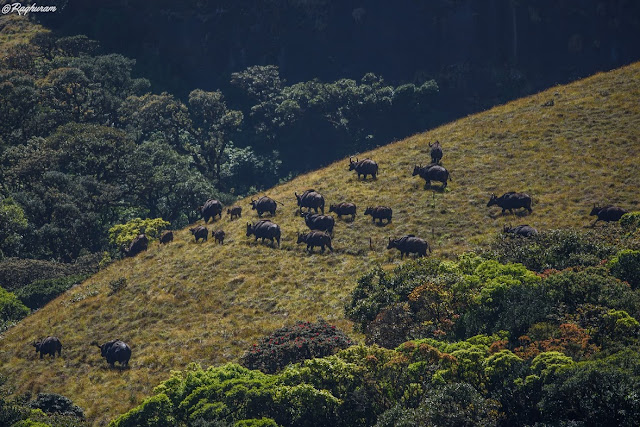A 4-day rapid Biodiversity Assessment of Munnar
Wildlife division concluded here with interesting findings. The survey was
conducted as a joint exercise of Munnar Wildlife Division of Kerala forests and
Wildlife department and experts from various NGO’s and Institutes in southern
India.
The survey was conducted at in all the National Parks
and Wildlife Sanctuaries of the Munnar landscape. Around 120 volunteers and
almost 60 Forest staff participated in the 4 day programme. The survey was
attended by volunteers from Travancore Nature History Society (TNHS)Trivandrum,
KFRI Peechi, ZSI Calicut, Kerala Agricultual University, Ecologists and staff
from Kerala Forest Department, Birders
Sans Borders Thrissur, Green Roots Alleppy, Ferns Waynad, MNHS
Calicut, SEEK Kannur, BBC Bangalore, TNBS Tamil Nadu, Rajapalayam Butterfly
Club , Wynter-Blyth Association, Centre
For Wildlife Studies Wayanad, KVASU Wayand, and Pondicherry University.
The event was inaugurated at Munnar Forest
office on 22nd Feb by the Wildlife Warden Mrs Lakshmi Arun. “Management plans
of most of the Protected areas in Munnar Landscape lacks an updated faunal
checklist for example birds and butterflies” said Mrs Lakshmi Wildlife Warden.
She stressed the need for systematic assessment of biodiversity where the data
is directly handed over to the park managers for improved practices, in the
inaugural address.
Mr Siby, Range Officer of Shola NP stressed on the
importance of these citizen science initiatives and expressed the need for
training the field staff at the grassroot level. Mr Sandeep, RO Eravikulam NP
briefed the participants about the logistics of the programme and the
arrangements.Mr Prabhu RO Chinnar, expressed his views on Rapid Biodiversity
Assessment and need for more such citizen science initiatives for better
management of our PA’s.
Dr.Kalesh.S from TNHS explained to the
participants the Survey methodology in the preliminary session. The delegates
were assigned to smaller teams composed of experts and volunteers into 24
basecamps in the protected areas. Eravikulam National park had 7 survey blocks,
Mathikettan Shola NP was divided into 2 blocks, Anamudi shola national park
into 3, Chinnar into 7, Pampadum shola into 3 and Kurinjimala Sanctuary into 2
blocks.
A total of 220 species of birds and 186 species of
butterflies were recorded over 4 days, it must be kept in mind that Kerala has
about 515 species of birds and 320 species of Butterflies.
Interesting findings among birds are Shaheen falcon,
Legge’s Hawk eagle, Chiffchaff, and endemic birds like Nilgiri Pipit, Black and
orange Flycatcher, Nilgiri Flycatcher and Broad tailed Grassbird.
The Southern Birdwing, the largest butterfly in our
country as well as the Grass Jewel the smallest butterfly in India were
recorded. Other interesting species recorded were the Western Ghats endemics
like Red-disc bushbrown, Palni bushbrown, Palni four ring, Palni Fritillary,
Nilgiri clouded yellow, Nilgiri Tiger and Palni Sailor.
The participants also found direct and indirect evidences for presence of good population
of Tigers, Leopards, Elephants, and other mammals. Eighteen species of frogs, 15 species
of Odonates and 15 species of ants were also recorded in this off-season
survey. Among the ants, one new genera and 5 new species are expected after
rigorous study.
Dr Kalesh said “We need to undertake such Citizen
science initiatives were data is generated by close collaboration between
Forest Department, Nature conservation NGOs’, and other stakeholders, where
this data is directly passed on to the Managers (Forest Department) for
conservation and management at the loco-regional level”. He emphasized on the
need for establishment of National Databases under Government of India and
national jurisdiction, as envisaged in GBIF where India is a signatory. “This
data can be classified or declassified by our government and then later shared
on international platforms as per agreements” he said.
Strong concerns were raised against the recent trend
of indiscriminate and unscrupulous use of ebird tool inside sensitive
areas like National Parks and Wildlife Sanctuaries of Kerala, where our
sensitive Biodiversity data is being rampantly drained into server in a foreign
country controlled by a foreign agency not under our jurisdiction. The Munnar
survey, in striking contrast, was conducted based on Pre-printed Checklists and
Transect Methodology, instead of the electronic or mobile platforms, there by
suggesting this as alternative tool for systematic faunal surveys of birds,
butterflies and Odonates and other faunal atlases.
The data generated from this massive exercise will be
used by the Forest Department for use in the Management plans of the National
Parks and sanctuaries. The programme concluded at Munnar on 25th Feb presided
by the Warden and Range officers from Kerala Forest Department.
News Article - Winged beauties find Munnar home - Deccan Chronicle - February 27, 2018
 |
| Photo by Ajith Kumar S |
 | |||||
| Black and Orange Flycatcher - Photo by Raghu Ram |
 |
| Photo by Apsal Shereef |
 |
| Palni Fritillary - Photo by Kiran M R |
 |
| Photo by Kiran M R |
 |
| Nilgiri Thar - Photo by Kiran M R |
 |
| Photo by Raghu Ram |
 |
| Photo by AjithKumar S |


nice information. Thanks a lot for sharing it. http://healthtipscare.com
ReplyDeleteWelcome, hope our article inspire you more
DeleteAwesome, Thanks for contributing your important time to post such an interesting & useful collection of knowledgeable resources that are always of great need to everyone. I visit this blog first time and encourage by this good stuff work. Unbelievable post keeps up posting such great information. There are things here that I didn't think some time as of late. am very enjoyed for this weblog. panseva It’s an informative subject matter.
ReplyDeleteThanks and happy that our articles adds interests and knowledge to you.
DeleteWow. Awesome picture. It's look very beautiful. Thanks for sharing with us.
ReplyDeleteThank you
Delete